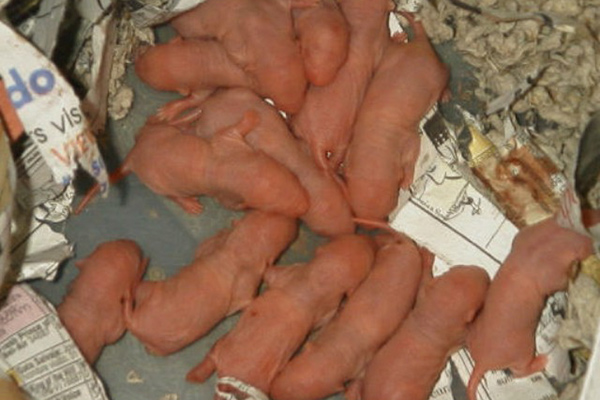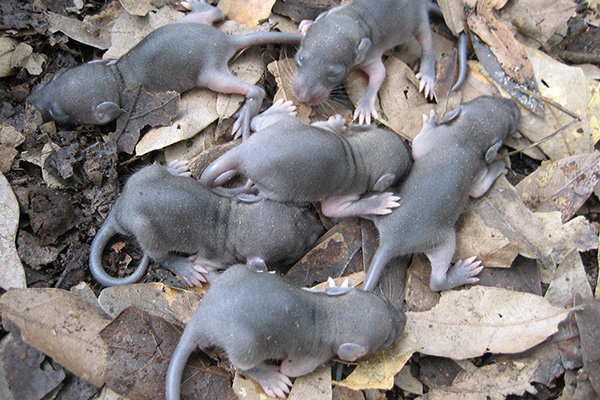- info@animalatticpest.com
- Call - we service 300 locations

Rat Nest in Attic - Nest of Baby Rats
Yes, if you have a rat infestation, or even just what you think are a few rats in your attic, there is a nest of baby rats. They reproduce very often, up to ten litters of young per year per female rat, so they very likely have a nest of babies. The nest is a small round cavity, probably in the insulation of the house, maybe lined with leaves or other plant debris. When removing certain animals from attics, like raccoons or squirrels, it's important to seek out and remove the nest of young. With rats, these nests are very hard to find, and the young don't really have any chance of survival, so I don't make the finding and removal of baby rat nests a part of my normal rodent control process. If you want to find and remove rat nests, you are welcome to. You just have to search down in the insulation or walls where you see high levels of rat activity. I have come across a few nests in my time as a wildlife removal expert, but they are usually well-concealed. To solve a rat problem, read my how to get rid of rats in the attic page. If you want to hire a pro, read how much does rat removal cost?
Rat Nest in Attic - Nest of Baby Rats

Pinkies - Maybe 1 Day Old
Here's a nest of baby rats. These are newborns, or maybe 1 day old at most. Many people refer to them at this size as "pinkies". These rats are often used as pet food for various snakes, birds, lizards, etc.

Starting to Get Fur - About 1 Week Old?
I actually don't know how to tell the age of baby rats. They grow so fast. Other photos on the internet indicate that these little ones are likely a week old or so.
Information About Nest of Baby Rats in the Attic
What should I do if I find a nest of rats in the attic? So one day you decided to clean out your attic and you found that there was much more than you had bargained for. You find that a group of rats have built a nest in your attic, and now you are trying to figure out how to get rid of them.
Let’s first start with the essential – do not panic and do not do anything rash. Most people see these animals and start trying to scurry them away. They think scattering is going to solve the problem, but consider that all you did is send a group of rats from one location in your home to all over your home now. That would not be the right play at all, so settle down and take a deep breathe first.
The best thing for you is that they stay in the attic for now. This keeps them out of your kitchen, living room, and even your bedroom. You sure don’t want them in a place where they will have direct contact with you, your family and pets, so let’s focus on keeping them in the attic for the moment.
Now you have two options available to you. The first is the more permanent one, which is to find out their entry holes, and seal them shut, with steel. I have outlined the steps for this extensively on this site. This doesn't address the matter of a nest of baby rats stuck inside. The truth is
that during the rat exclusion and removal process, the nest of baby rats, if there is one or two, will be subject to starvation due to the removal of the milk-bearing mother rat, and they will die in the attic.
You can also buy traps to take care of the problem. There are two basic types of rat traps; one is the steel cage trap made for catching them alive while the other is the snap trap made for ending the rat’s life. The ones that work to end the rat’s life are single use that either need
to be reset once you catch a rat or thrown out. The other type can catch up to as many as three or four rats at a time, and then you can decide what to do with them once they are captured. You can terminate them or let them go some other place.
Remember, do not set out some poison pellets. It's true that some of the rats will eat the pellets and die within a short period of time. But not all, and not the baby rats in the nest. Now, you may think that all you have to do is throw away the rats and clean up and you are all set and that this can
be highly effective, but of course the truth is that the rats will die in very hard-to-find areas, and create a huge odor problem.
If you kill the adult rats and do not remove the nest of baby rats, they will starve to death and die and stink as well. However, they will be very small in size, and low on body mass due to starvation, so the odor will be lower. But it will still be present. I have been called to remove
dead baby rat nests from inside ceilings and walls.
Of course, if you do use poison, you want to be sure that only the rats can get to the poison. If your cat, dog, or even your children can get into this area then you are risking their health greatly. You may think you can safely use rodenticides if you find that access to the attic is not easy
for the other members of your home. But even though that is the case, and even though poison is safe, it is simply not effective!
